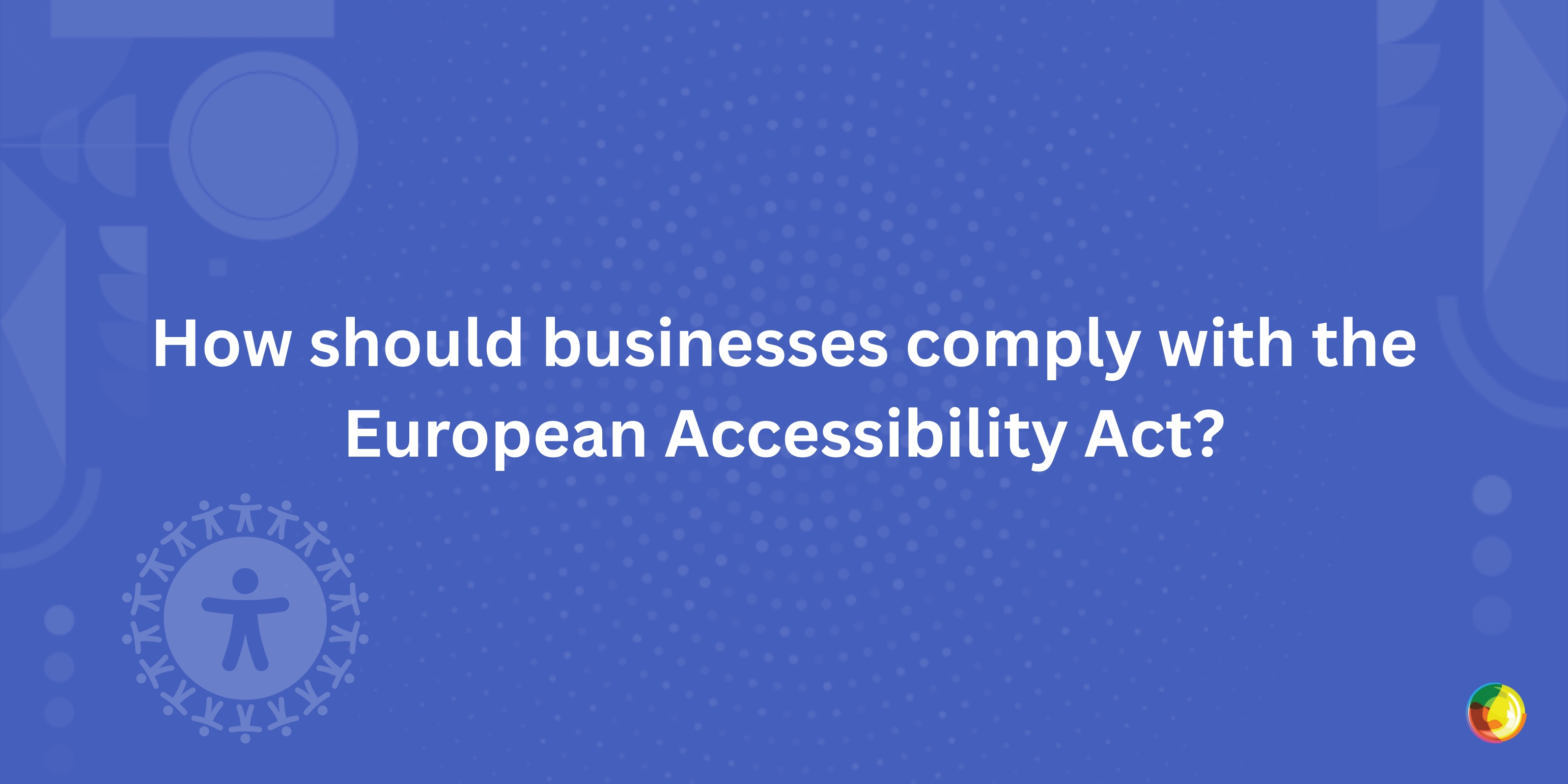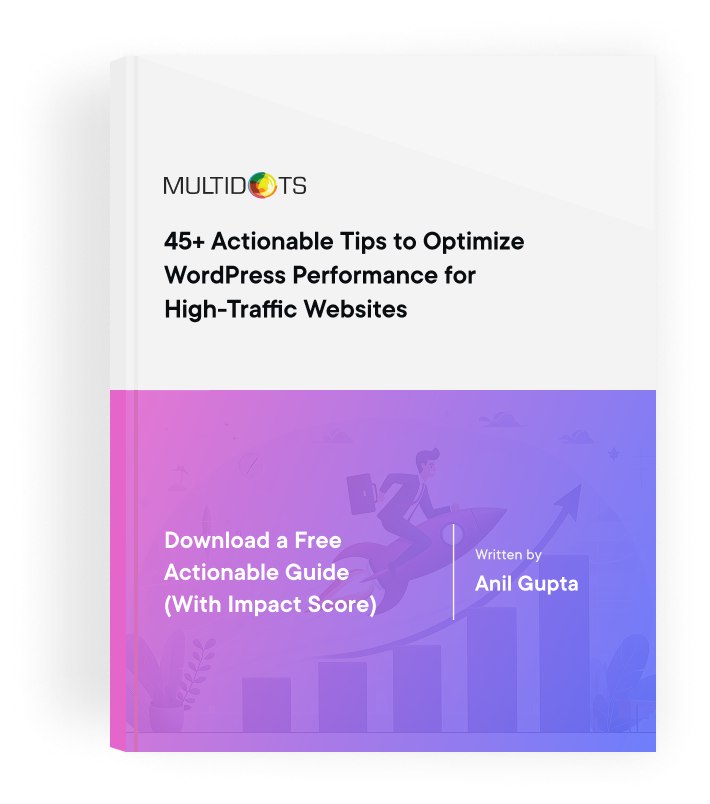Is Your WordPress Website Ready for the European Accessibility Act (EAA)?
Everything WordPress site owners need to know about the upcoming European Accessibility Act and how to get compliant before the June 2025 deadline.

Table of Contents
The European Union is bringing in a major change. Starting June 28, 2025, most websites and digital services in the EU must meet new accessibility standards. This change comes under the European Accessibility Act (EAA).
If your business runs a website or mobile app that serves users in the EU, these rules apply to you. Even businesses outside the EU need to comply if they serve European customers.
If you use WordPress, there is a clear path to compliance. In this guide, we will explain what the EAA means, who it affects, what needs to change on your site, and how Multidots can help.
What Is the European Accessibility Act (EAA)?
The European Accessibility Act, or EAA, is a law passed by the European Union. Its goal is to make websites, mobile apps, and digital services easier to use for people with disabilities.
The EAA was approved in 2019. It becomes enforceable on June 28, 2025. The law applies across all EU member states, and it builds on earlier accessibility rules for government websites. Now, it also includes private companies that offer digital services to the public.
This law is similar to how the EU introduced GDPR for data privacy. The EAA does something similar for digital accessibility.
Who Must Comply With the EAA?
The EAA applies to a wide range of businesses. Here are the main groups that must comply:
- E-commerce websites
- Online banking and finance platforms
- Streaming and entertainment platforms
- Travel and transportation booking websites
- E-book platforms
- Any digital service that targets consumers in the EU
If your company is outside the EU but sells products or offers services to EU customers, you also need to comply.
There is an exception for microenterprises. These are companies with fewer than 10 employees and less than €2 million in annual turnover. However, even these businesses are encouraged to follow accessibility best practices.
Understanding the Difference Between EAA and WCAG
A common question is how the European Accessibility Act (EAA) compares to the Web Content Accessibility Guidelines (WCAG).
Here’s the difference:
- EAA is a law. It is a legal requirement in the European Union that businesses must follow. It defines who must comply, when, and why.
- WCAG is a technical standard. It tells you how to make your website accessible. It provides practical guidance on design, structure, and usability for people with disabilities.
In simple terms: The EAA is the rulebook. WCAG is the instruction manual.
Most businesses follow WCAG 2.1 Level AA to meet EAA rules. This is the standard used by regulators, auditors, and courts to check if a website is accessible.
Therefore, WCAG is the standard you need to meet.
What Does Accessibility Mean in Practice?
The EAA does not list exact technical rules. But in practice, websites are expected to follow the WCAG 2.1 Level AA standards. These are the most widely accepted guidelines for web accessibility.
Let’s break this down into simpler terms. A compliant website should be:
1. Perceivable
People with disabilities should be able to perceive content in more than one way. This includes:
- Alt text for images
- Captions for videos and transcripts for audio
- Strong contrast between text and background
- Text that can be resized
2. Operable
Users should be able to interact with your site in multiple ways. For example:
- Full keyboard navigation (no need to use a mouse)
- Buttons and links are easy to identify
- No flashing content that can cause seizures
3. Understandable
Visitors should be able to understand the content and how to use the site:
- Clear instructions for filling out forms
- Consistent menus and navigation
- Simple, readable language
4. Robust
Your site should work well with assistive technologies such as:
- Screen readers
- Screen magnifiers
- Voice input tools
Why Accessibility Is Good for Everyone
While the EAA makes accessibility a legal requirement, the real value goes beyond compliance.
Here’s what accessible websites do better:
- Reach a wider audience. Over 135 million people in Europe live with a disability. Accessibility allows more people to fully use your site, no matter their abilities.
- Create better experiences for everyone. Features like clear forms, keyboard navigation, and readable text help all users, not just those with impairments.
- Improve trust and brand reputation. Users are more likely to trust brands that are inclusive and respectful of different needs.
- Future-proof your site. Accessibility is not just a 2025 issue. It’s part of building ethical, long-term digital experiences.
When you invest in accessibility, you are investing in people. It’s not just about laws, it’s about doing what’s right.
Accessibility and Mobile Experience
Many users rely on mobile devices as their primary way to access digital content. For people with disabilities, mobile accessibility is just as important as desktop accessibility, and the EAA applies to both.
The mobile version of your website or app must be fully usable for people with:
- Vision impairments (e.g., using screen readers or high-contrast modes)
- Limited mobility (e.g., using touch alternatives or voice commands)
- Cognitive disabilities (e.g., needing clear layouts and simple navigation)
Common mobile issues include buttons that are too small, poor contrast in bright environments, or hidden navigation menus that are hard to find without a mouse.
If your site uses WordPress, your mobile design must follow the same accessibility principles as your desktop version. That includes readable text, accessible forms, and easy-to-use navigation on smaller screens.
The takeaway: Accessibility must be built into responsive design. It’s not just about scaling down the layout but maintaining usability for all users, across all devices.
Beyond the Interface: Additional EAA Requirements
The EAA also asks for more than just accessible design. Businesses must take extra steps to meet the full requirement.
These include:
- An Accessibility Statement: This is a page on your website where you explain your compliance status. It should also explain what a visitor can do if they face any issues.
- Feedback Channels: Users should be able to report problems or request accessible formats.
- Accessible PDFs and Documents: If you share downloadable content, it should work well with screen readers.
- Accessible Checkouts: If you sell products online, your checkout process needs to be usable by all users, including those using assistive tools.
What Happens If You Don’t Comply?
Starting in June 2025, non-compliance can lead to serious issues.
Each EU country will enforce the law through its own national systems. So, penalties will vary depending on the country. But here is what could happen:
- Fines and legal action
- Your service could be blocked from operating in the EU
- Damage to your brand reputation, especially if your company is seen as excluding people with disabilities
Just like with GDPR, regulators are expected to enforce EAA compliance seriously, including penalties and audits. It is better to prepare now instead of rushing later.
What Does This Mean for WordPress Site Owners?
If you run your website on WordPress, you are already in a flexible and open ecosystem. But accessibility does not happen automatically.
You still need to make smart choices around:
- Themes and templates
- Plugins
- Content layout
- Media (images, videos, files)
- Code structure
Some common mistakes we see include:
- Assuming all themes and plugins are accessible
- Relying only on automated tools to check accessibility
- Treating accessibility as a one-time task
- Ignoring how forms, checkout pages, and PDFs behave
- Skipping the Accessibility Statement page
To meet EAA standards, you need a full strategy, not just a quick fix.
What Should You Do Next? A Quick Checklist
If you’re running a WordPress site that operates in the EU or serves EU users, here’s what you should do:
- Audit your current site for accessibility using both automated and manual tools
- Review your theme and plugins to ensure they support accessible features
- Fix key areas like image alt text, keyboard navigation, forms, color contrast, and headings
- Ensure PDFs and downloads are accessible with screen readers
- Make your checkout flow usable with assistive technology
- Add an accessibility statement and feedback mechanism
- Train your team on how to publish accessible content going forward
Feeling overwhelmed? Multidots is here to simplify the process for you.
Why Multidots?
At Multidots, we help businesses of all sizes improve their digital experience on WordPress. We specialize in enterprise-grade accessibility solutions for websites that need to comply with international standards like the EAA.
We’ve helped media companies, enterprise websites, and eCommerce stores become compliant with global accessibility laws. Our team of WordPress engineers, designers, and strategists understand how to make complex websites accessible without hurting performance or aesthetics.
Example 1: Multidots supported a high-traffic publishing network in migrating to WordPress VIP. As part of the project, we restructured content templates, streamlined code, and enhanced UI components for better accessibility.
These updates made the site more compatible with screen readers, improved keyboard navigation, and laid the groundwork for accessibility compliance. The client is now better positioned to meet upcoming EAA requirements while delivering a more inclusive experience to all users.
Example 2: For a major news and entertainment publisher, we migrated multiple high-volume websites to WordPress VIP. As part of this transition, we rebuilt the sites with a focus on cleaner design, better content structure, and accessibility readiness.
Our team ensured the new setup could support clearer navigation and better compatibility with assistive technologies. This positioned the client to scale responsibly while aligning with EAA compliance goals.
We treat accessibility as a design, development, and strategy problem, not just a checklist.
Our edge comes from doing deep audits, making hands-on code improvements, and training in-house teams to keep their site accessible long-term.
Here is how we implement the above:
1. WordPress Accessibility Audits
We combine automated scans with manual reviews to check every area of your site. Our audits follow WCAG 2.1 AA standards and align with the EAA’s legal goals.
2. Theme and Plugin Optimization
We help you choose the right themes and plugins, or we build custom components that are accessible from the start.
3. Custom Remediation
We fix accessibility issues in your existing setup — including navigation, content structure, checkout flows, and PDF downloads. We handle it all.
4. Accessibility Statement and Feedback Setup
We set up your Accessibility Statement page and connect the right tools for user feedback. This makes your compliance clear and traceable.
5. Training and Long-Term Support
We train your team on how to publish accessible content. We also offer ongoing support to make sure future changes stay compliant.
Accessibility Helps SEO and User Experience
Improving accessibility often leads to better SEO. That’s because many of the same practices like using headings properly, writing clear alt text, and improving site speed can also help search engines understand your site.
Accessible websites also provide a better experience for all users, not just those with disabilities. When you remove barriers, you reduce bounce rates, improve time on site, and increase conversions.
So by making your WordPress site accessible, you are also making it more successful.
TL;DR
- The European Accessibility Act takes effect from June 28, 2025.
- WordPress websites serving EU users must follow WCAG 2.1 AA standards.
- You need to provide alt text, keyboard support, readable design, accessible checkouts, and an accessibility statement.
- Accessibility is not just legal compliance. It’s good for business, SEO, and user trust.
- Multidots offers full support; from audits to fixes to help your WordPress site stay compliant.
Start Now. Don’t Wait for the Deadline
Making your website accessible is not just about ticking a box. It’s about building trust, showing responsibility, and reaching more people.
June 2025 is not far away. If you start now, you will have time to fix problems, test changes, and train your team.
At Multidots, we are ready to support you at every step. Whether you need an audit, full remediation, or ongoing help, we’ve got you covered.
If you need any assistance to comply with international standards like the EAA on your WordPress website, please don't hesitate to contact us.
FAQs
-
Yes. If your website serves customers or users in the EU, you need to follow the rules.
-
No. Plugins can help, but they cannot fix everything. Many issues require custom code updates and content changes.
-
Websites launched before June 2025 can remain operational until June 2030. However, any new content, features, or updates after June 2025 must comply with the EAA from day one.
-
The EAA does not mention WCAG directly, but following WCAG 2.1 AA is the best way to ensure compliance.
Let us help you align your WordPress site with EAA standards — it's not just a requirement, it's a responsibility.
Contact Us
